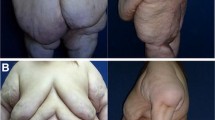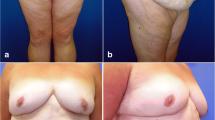Summary
Background
The number of patients requiring post-bariatric body-contouring after massive weight loss (MWL) is steadily increasing. The management of this demanding clientele of patients is challenging and requires a structured approach. The aim of this article is to provide a detailed overview of the contouring approach to the lower body after MWL practiced at Innsbruck Medical University, Department of Plastic, Reconstructive and Aesthetic Surgery, along with an analysis of the procedures over a 10-year period. Special attention is given to the surgical challenges, such as patients presenting with pre-existing scars in the upper abdomen.
Methods
A detailed overview of the patient selection as well as the patient evaluation process requiring abdominal, trunk, and thigh-contouring is outlined. The anatomic basis for abdominal and thigh-contouring is depicted along with a detailed depiction of the relevant procedures for abdominal and thigh-contouring, both in presence and without pre-existing scars. Furthermore, an analysis of the patients treated at Innsbruck Medical University for lower body-contouring between January 2002 and June 2012 with respect to selected patient demographics and epidemiology of procedures is performed.
Results
The key to satisfactory results is a thorough analysis of the horizontal and vertical skin and fat excess of the abdomino-torso, buttock and flank areas as well as the thigh areas and choosing an adequate and safe procedure addressing the respective areas of skin and fat excess. Special attention must be given to the distribution and position of pre-existing scars. Within the 10.5-year period, a total of 624 abdominal-contouring and 46 medial thigh-contouring procedures were performed. In 41 cases, tailored techniques were applied paying attention to pre-existing scars. The majority of patients were female (91 %). The average patient age equaled 40.6 years.
Conclusions
A structured approach, analyzing the distribution and composition fat and skin excess in the respective body areas allows for functional, aesthetic and safe and lower body-contouring.





Similar content being viewed by others
References
Spivak H, Hewitt MF, Onn A, Half EE. Weight loss and improvement of obesity-related illness in 500 U.S. patients following laparoscopic adjustable gastric banding procedure. Am J Surg. 2005;189:27–32.
Savage RC. Abdominoplasty following gastrointestinal bypass surgery. Plast Reconstr Surg. 1983;71:500–9.
Rieger UM, Heider I, Bauer T, Hussl H, Schoeller T, Pierer G. Treatment algorithm for abdomino-torso body contouring in massive weight-loss patients in the presence of scars: a comprehensive review. J Plast Reconstr Aesthet Surg. 2011;64:563–72.
Bruschi S, Datta G, Bocchiotti MA, Boriani F, Obbialero FD, Fraccalvieri M. Limb contouring after massive weight loss: functional rather than aesthetic improvement. Obes Surg. 2009;19:407–11.
Hurwitz DJ. Single-staged total body lift after massive weight loss. Ann Plast Surg. 2004;52:435–41.
Athiye BS, Hayek, S, Ibrahim A. Thigh lift. In: Athiye BS, Costagliola M, editors. Body contouring following bariatric surgery and massive weight loss: post-bariatric body contouring. Dubai: Bentham Science Publishers; 2012:79–87.
Hurwitz DJ, Rubin JP, Risin M, Sajjadian A, Sereika S. Correcting the saddlebag deformity in the massive weight loss patient. Plast Reconstr Surg. 2004;114:1313–25.
Taylor J, Shermak M. Body contouring following massive weight loss. Obes Surg. 2004;14(8):1080–5.
Neaman KC, Hansen JE. Analysis of complications from abdominoplasty: a review of 206 cases at a university hospital. Ann Plast Surg. 2007;58:292–8.
Rieger U, Scheufler O, Schmid D, Zweifel-Schlatter M, Kalbermatten D, Pierer G. Six treatment principles of the basle pressure sore concept. Handchir Mikrochir Plast Chir. 2007;39:206–14.
Rieger UM, Erba P, Kalbermatten DF, Schaefer DJ, Pierer G, Haug M. An individualized approach to abdominoplasty in the presence of bilateral subcostal scars after open gastric bypass. Obes Surg. 2008;18:863–9.
Podnos YD, Jimenez JC, Wilson SE, Stevens CM, Nguyen NT. Complications after laparoscopic gastric bypass: a review of 3464 cases. Arch Surg. 2003;138:957–61.
Hesselink VJ, Luijendijk RW, de Wilt JH, Heide R, Jeekel J. An evaluation of risk factors in incisional hernia recurrence. Surg Gynecol Obstet. 1993;176:228–34.
Hunstad JP, Repta R. Atlas of abdominoplasty. Philadelphia: Saunders Elsevier; 2009.
Rieger UM. Abdominal contour surgery for the massive weight loss patient. In: Athiye BS, Costagliola M, editors. Body contouring following bariatric surgery and massive weight loss: post-bariatric body contouring. Dubai: Bentham Science Publishers; 2012:63–78.
de Castro CC, Aboudib JJ, Salema R, Gradel J, Braga L. How to deal with abdominoplasty in an abdomen with a scar. Aesthetic Plast Surg. 1993;17:67–71.
Rieger UM, Petschke F, Djedovic G, Engelhardt TO, Biebl M, Pierer G. Abdominal wall reconstruction after extensive abdominal wall necrosis resulting from chevron incision for liver transplant and subsequent Y-shaped incision for re-transplantation: clinical experience and literature review. J Plast Reconstr Aesthet Surg. 2012;65:e71–3.
Mathes DW, Kenkel JM. Current concepts in medial thighplasty. Clin Plast Surg. 2008;35:151–63.
Lockwood TE. Transverse flank-thigh-buttock lift with superficial fascial suspension. Plast Reconstr Surg. 1991;87:1019–27.
Kenkel JM, Eaves FF III. Medial thigh lift. Plast Reconstr Surg. 2008;122:621–2.
Lockwood TE. Fascial anchoring technique in medial thigh lifts. Plast Reconstr Surg. 1988;82:299–304.
Shermak MA, Rotellini-Coltvet LA, Chang D. Seroma development following body contouring surgery for massive weight loss: patient risk factors and treatment strategies. Plast Reconstr Surg. 2008;122:280–8.
Pitanguy I, Mayer B, Labrakis G. Abdominoplasty: personal surgical guidelines. Zentralbl Chir. 1988;113:765–71.
Manahan MA, Shermak MA. Massive panniculectomy after massive weight loss. Plast Reconstr Surg. 2006;117:2191–7.
Dini M, Mori A, Cassi LC, Lo RG, Lucchese M. Circumferential abdominoplasty. Obes Surg. 2008;18:1392–9.
Cardoso de Castro C, Salema R, Atias P, Aboudib JH Jr. T abdominoplasty to remove multiple scars from the abdomen. Ann Plast Surg. 1984;12:369–73.
Dellon AL. Fleur-de-lis abdominoplasty. Aesthetic Plast Surg. 1985;9:27–32.
Borud LJ, Warren AG. Modified vertical abdominoplasty in the massive weight loss patient. Plast Reconstr Surg. 2007;119:1911–21.
Song AY, Rubin JP, Thomas V, Dudas JR, Marra KG, Fernstrom MH. Body image and quality of life in post massive weight loss body contouring patients. Obesity (Silver Spring). 2006;14:1626–36.
Rieger UM, Aschwanden M, Schmid D, Kalbermatten DF, Pierer G, Haug M. Perforator-sparing abdominoplasty technique in the presence of bilateral subcostal scars after gastric bypass. Obes Surg. 2007;17:63–7.
Matarasso A. Liposuction as an adjunct to a full abdominoplasty. Plast Reconstr Surg. 1995;95:829–36.
Rieger UM, Erba P, Wettstein R, Schumacher R, Schwenzer-Zimmerer K, Haug M, Pierer G, Kalbermatten DF. Does abdominoplasty with liposuction of the love handles yield a shorter scar? An analysis with abdominal 3D laser scanning. Ann Plast Surg. 2008;61:359–63.
Hsieh F, Kumiponjera D, Malata CM. An algorithmic approach to abdominal flap breast reconstruction in patients with pre-existing scars: results from a single surgeon’s experience. J Plast Reconstr Aesthet Surg. 2009;62(12):1650–60.
Rieger UM. Skin sensory function in post-bariatric patients-implications for selection of post-bariatric abdominal body-contouring techniques. Obes Surg. 2012;22:342.
Le Louarn C, Pascal JF. The concentric medial thigh lift. Aesthetic Plast Surg. 2004;28:20–3.
Candiani P, Campiglio GL, Signorini M. Fascio-fascial suspension technique in medial thigh lifts. Aesthetic Plast Surg. 1995;19:137–40.
Mayr M, Holm C, Hofter E, Becker A, Pfeiffer U, Muhlbauer W. Effects of aesthetic abdominoplasty on abdominal wall perfusion: a quantitative evaluation. Plast Reconstr Surg. 2004;114(6):1586–94.
Cintra W Jr., Modolin ML, Gemperli R, Gobbi CI, Faintuch J, Ferreira MC. Quality of life after abdominoplasty in women after bariatric surgery. Obes Surg. 2008;18:728–32.
Walgenbach KJ, Shestak KC. “Marriage” abdominoplasty: body contouring with limited scars combining mini-abdominoplasty and liposuction. Clin Plast Surg. 2004;31:571–81.
Spirito D. Medial thigh lift and DE.C.LI.VE. Aesthetic Plast Surg. 1998;22:298–300.
Kirwan L. Anchor thighplasty. Aesthet Surg J. 2004;24:61–4.
Rieger UM, Erba P, Pierer G, Kalbermatten DF. Hidradenitis suppurativa of the groin treated by radical excision and defect closure by medial thigh lift: aesthetic surgery meets reconstructive surgery. J Plast Reconstr Aesthet Surg. 2009;62:1355–60.
Author information
Authors and Affiliations
Corresponding author
Rights and permissions
About this article
Cite this article
Rieger, U., Djedovic, G., Bauer, T. et al. Approach to the lower body after massive weight loss: the Innsbruck experience with abdomino-torso and thigh-contouring after massive weight loss. Eur Surg 45, 66–74 (2013). https://doi.org/10.1007/s10353-012-0171-y
Received:
Accepted:
Published:
Issue Date:
DOI: https://doi.org/10.1007/s10353-012-0171-y




